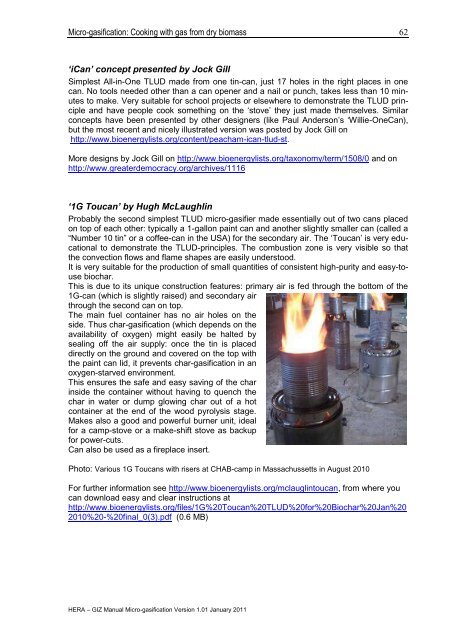Micro-gasification: Cooking with gas from biomass - Amper
Micro-gasification: Cooking with gas from biomass - Amper
Micro-gasification: Cooking with gas from biomass - Amper
You also want an ePaper? Increase the reach of your titles
YUMPU automatically turns print PDFs into web optimized ePapers that Google loves.
<strong>Micro</strong>-<strong><strong>gas</strong>ification</strong>: <strong>Cooking</strong> <strong>with</strong> <strong>gas</strong> <strong>from</strong> dry <strong>biomass</strong><br />
‘iCan’ concept presented by Jock Gill<br />
Simplest All-in-One TLUD made <strong>from</strong> one tin-can, just 17 holes in the right places in one<br />
can. No tools needed other than a can opener and a nail or punch, takes less than 10 minutes<br />
to make. Very suitable for school projects or elsewhere to demonstrate the TLUD principle<br />
and have people cook something on the ‗stove‘ they just made themselves. Similar<br />
concepts have been presented by other designers (like Paul Anderson‘s ‗Willie-OneCan),<br />
but the most recent and nicely illustrated version was posted by Jock Gill on<br />
http://www.bioenergylists.org/content/peacham-ican-tlud-st.<br />
More designs by Jock Gill on http://www.bioenergylists.org/taxonomy/term/1508/0 and on<br />
http://www.greaterdemocracy.org/archives/1116<br />
‘1G Toucan’ by Hugh McLaughlin<br />
Probably the second simplest TLUD micro-<strong>gas</strong>ifier made essentially out of two cans placed<br />
on top of each other: typically a 1-gallon paint can and another slightly smaller can (called a<br />
―Number 10 tin‖ or a coffee-can in the USA) for the secondary air. The ‗Toucan‘ is very educational<br />
to demonstrate the TLUD-principles. The combustion zone is very visible so that<br />
the convection flows and flame shapes are easily understood.<br />
It is very suitable for the production of small quantities of consistent high-purity and easy-touse<br />
biochar.<br />
This is due to its unique construction features: primary air is fed through the bottom of the<br />
1G-can (which is slightly raised) and secondary air<br />
through the second can on top.<br />
The main fuel container has no air holes on the<br />
side. Thus char-<strong><strong>gas</strong>ification</strong> (which depends on the<br />
availability of oxygen) might easily be halted by<br />
sealing off the air supply: once the tin is placed<br />
directly on the ground and covered on the top <strong>with</strong><br />
the paint can lid, it prevents char-<strong><strong>gas</strong>ification</strong> in an<br />
oxygen-starved environment.<br />
This ensures the safe and easy saving of the char<br />
inside the container <strong>with</strong>out having to quench the<br />
char in water or dump glowing char out of a hot<br />
container at the end of the wood pyrolysis stage.<br />
Makes also a good and powerful burner unit, ideal<br />
for a camp-stove or a make-shift stove as backup<br />
for power-cuts.<br />
Can also be used as a fireplace insert.<br />
Photo: Various 1G Toucans <strong>with</strong> risers at CHAB-camp in Massachussetts in August 2010<br />
For further information see http://www.bioenergylists.org/mclauglintoucan, <strong>from</strong> where you<br />
can download easy and clear instructions at<br />
http://www.bioenergylists.org/files/1G%20Toucan%20TLUD%20for%20Biochar%20Jan%20<br />
2010%20-%20final_0(3).pdf (0.6 MB)<br />
HERA – GIZ Manual <strong>Micro</strong>-<strong><strong>gas</strong>ification</strong> Version 1.01 January 2011<br />
62
















